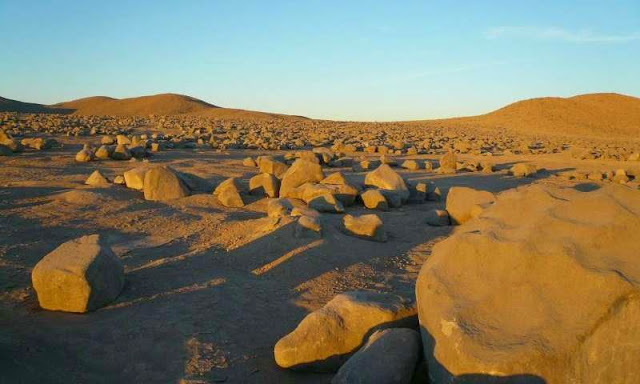
Researchers have pinpointed the driest location on Earth in the Atacama Desert, a region in Chile already recognised as the most arid in the world. They have also found evidence of life at the site, a discovery that could have far-reaching implications for the search for life on Mars.
For more than a decade, the Yungay region has been established as the driest area of the hyper-arid Atacama desert, with conditions close to the so-called “dry limit” for life on Earth. Several academic papers have been published reporting on the extraordinary characteristics of the site and its relevance to astrobiologists as an analogue of conditions on Mars. However, following a more systematic search of the desert, a Chilean research team has now found a new site, María Elena South (MES), which it describes as “much drier” than Yungay.
Lead author Armando Azua-Bustos, an environmental biologist and research scientist at the Blue Marble Space Institute of Science in Seattle, says the team discovered that MES has a mean atmospheric relative humidity (RH) of 17.3 percent and a soil RH of a constant 14 percent at a depth of one meter. This soil value matches the lowest RH measurements taken by the Mars Science Laboratory at Gale Crater on Mars, establishing the fact that conditions at the site are as dry as those found recently on the Martian surface.
“Remarkably, we found a number of viable bacterial species in the soil profile at MES using a combination of molecular dependent and independent methods, unveiling the presence of life in the driest place on the Atacama Desert reported to date,” Azua-Bustos says.
Microsensors
The team used microsensors, including atmospheric temperature and relative humidity loggers, to take detailed measurements of the microenvironmental conditions at the MES site. It also characterized the geochemical composition of the soils at the site to unveil the presence and type of microbial species able to survive under these conditions. The results are presented in the paper, “Discovery and microbial content of the driest site of the hyperarid Atacama Desert, Chile,” published in March in the journal Environmental Microbiology Reports.
Azua-Bustos has spent the last 12 years studying the Atacama Desert and developing the field of astrobiology in Chile, and in so doing earned the nickname “astrobiologist of the desert.” He first became interested in the region after reading what he describes as a “pivotal paper” published in the journal Science in 2003 by a research team led by Chris McKay, a planetary scientist at NASA Ames Research Center.
The paper proposed the Yungay region in the Atacama as a “pertinent Mars analogue model,” mainly due to its extreme dryness, the characteristics of its soils, the presence of organic species at trace levels and extremely low levels of culturable bacteria.
However, based on his experience as a native of the Atacama who was born and raised in the desert, Azua-Bustos was convinced that there were drier places than Yungay, so he decided to set RH sensors in several places that were potentially drier.
“We found at least three such places, the driest of which we describe in this paper,” he says.
Implications for Astrobiology
For Azua-Bustos, the fact that the conditions at MES site, in terms of dryness, are the closest to Mars as it is possible to get means that it is one of the best analogue models on Earth to understand and investigate the potential existence, and type of, microbial life in the Martian subsurface.
“This also implies that if you want to test the next generation of robots, instruments and other detection techniques and technologies in a Mars-like environment, this is one of the best you can find as it possesses many of the key characteristics that you will find on the Red Planet,” he says.
The site could also be used to conduct experiments that might inform future work carried out by the Mars Science Laboratory (MSL) at Gale Crater in its search for extant life on Mars. In Azua-Bustos’ view, one interesting experiment would be to test the same instruments being used by MSL at the MES site to compare results with the Martian data and to “further detail how similar both sites may be in terms of habitability, having the advantage of this new site in the Atacama as a positive control.”
For Azua-Bustos, the fact that we already know that there is life in the soil at María Elena South means that it would also be interesting to test if the sample analysis at Mars (SAM) instrument (a suite of three instruments, including a mass spectrometer, gas chromatograph, and tuneable laser spectrometer carried onboard the MSL rover), as well as similar detection instruments scheduled to be sent to Mars, are also able to detect life at a similarly dry terrestrial site.
“[K]nowing the amount, location in the subsoil and type of microbial life present in María Elena South, it would be of interest to test the SAM instruments here, in order to test its sensitivity in a site which you know is inhabited. In other words, if SAM or any other instrument were not able to detect life in Maria Elena soils, one could argue that SAM would not be sensitive enough to detect life on Mars,” he adds.
Reference:
“Mars-like soils in the Atacama Desert, Chile, and the dry limit of microbial life.” Science. 2003 Nov 7;302(5647):1018-21. www.ncbi.nlm.nih.gov/pubmed/14605363
“Discovery and microbial content of the driest site of the hyperarid Atacama Desert, Chile.” Environmental Microbiology Reports, 7: 388–394. DOI: 10.1111/1758-2229.12261
Note : The above story is based on materials provided by Astrobio.net.
This story is republished courtesy of NASA’s Astrobiology Magazine. Explore the Earth and beyond at www.astrobio.net.










